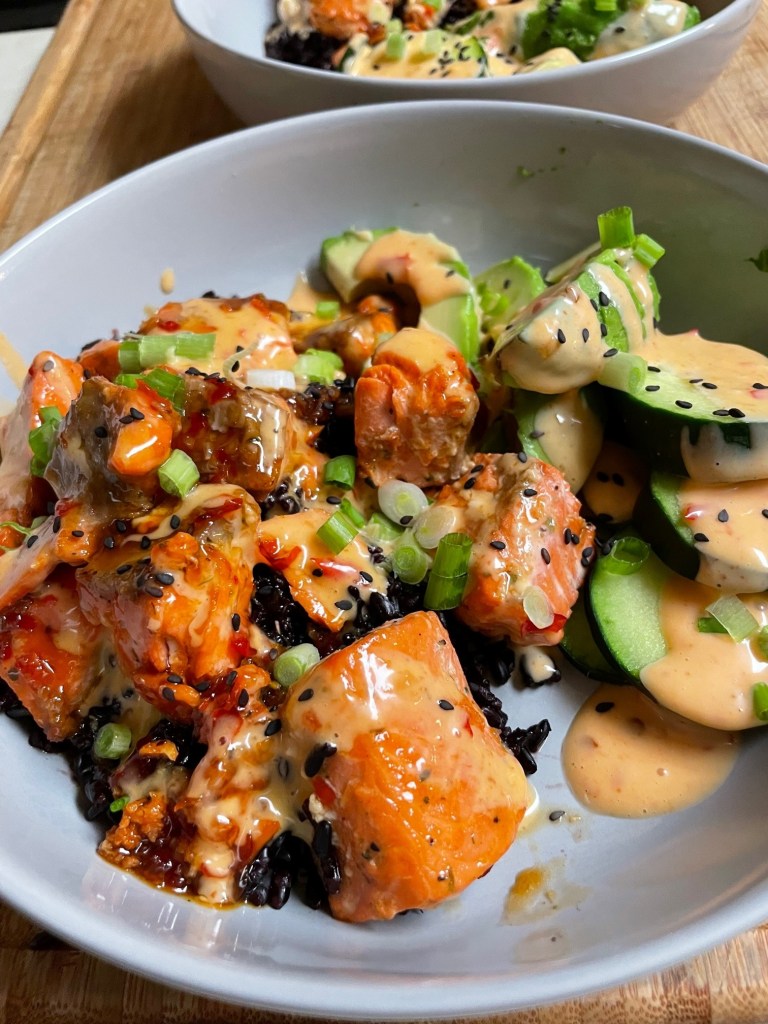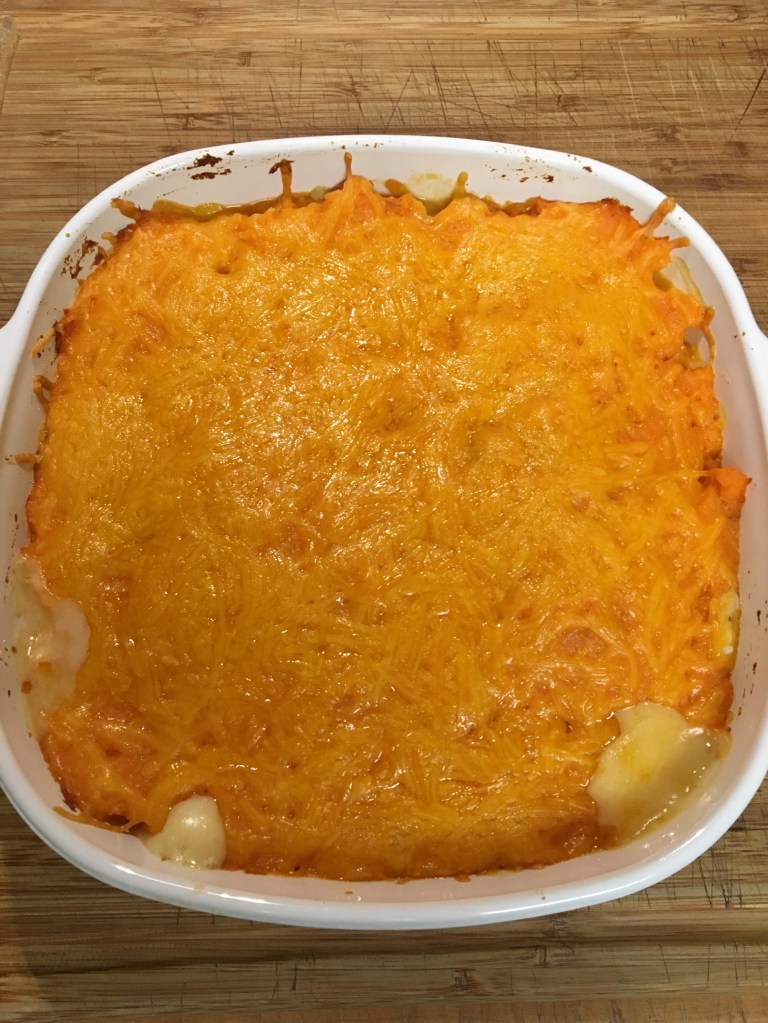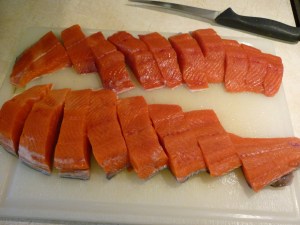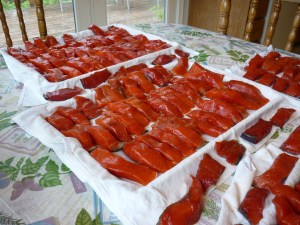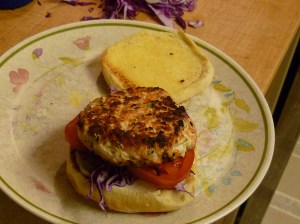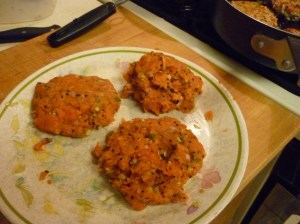You are currently browsing the tag archive for the ‘salmon’ tag.
- Ingredients
- Fresh (or frozen and thawed) salmon
- Sesame seeds
- Favorite seasoning salt
- Oil
Slice the salmon into evenly sized strips, about 1″ wide. I used three strips per person. Sprinkle sesame seeds onto a plate. Let’s call the salmon skin the bottom. Press one side of the salmon into the sesame seeds on the plate so that the side is well-coated. Heavily salt the other side, the side that is facing up toward you. That’s it for prep.
Heat just a little oil in a skillet until very hot. Place the salmon in the skillet, sesame side down, and sear it for a couple minutes. Do not crowd the fish. When you see the salmon turning pink about half way through, turn the salmon over so that the salted side is on the skillet. Let it finish cooking, a couple more minutes. Remove from skillet and let stand for a couple minutes. Serve.
This tastes really good sauced with tahini sauce.
NOTES: This tastes AMAZING!!! No joke. My son in Juneau (pictured below) made these and used blueberry salt for the salted side. He said it was AMAZING! I used garlic salt the last time I made these. I cannot overstate how good these are. It’s as though I discovered the perfect way to make salmon. Oh, but credit must go to Jamie Oliver for introducing me. Thank you.



How I ended up with more salmon than I know what to do with, but I’m working on it . . .
Last summer I bought 30 salmon from my friend Sandy. She has a small processing operation in Naknek. She fileted the fish for me. In Alaska parlance, that means she gutted the salmon and split the fish in half, removing the backbone. My memory from working at the Alaska Dept. of Fish and Game in King Salmon during summers 1975-1977 as a fish ticket editor and radio operator tells me the average size of a Bristol Bay sockeye salmon is 8 pounds. If you remove the guts and split it in half, that’s about 2.5-3 pounds of meat. I see salmon recipes online talking about filets and I just don’t know what that means. They clearly are using the word “filet” differently than I’m accustomed to. Oh, well. To me, a filet is half a fish. If it’s a Kasilof fish, it’s not very much. If it’s a Bristol Bay fish, it’s a lot.
Sandy asked me if I wanted the collars and bellies removed. I was trying to catch up on the lingo and told her I didn’t care, whatever was easiest. She left them. Thank goodness because that’s what I’m used to. I cut them off myself and boil them to make salmon broth for use in salmon chowder and other seafood chowders. Sandy asked if I wanted some bellies. She cuts them off for her customers outside Alaska. The filet makes a neater appearance that way. Sure, I took some bellies. I smoked and canned them, but they’re nearly all oil so it wasn’t very appetizing. I tossed some on the smoker, but still . . . too oily for me. I don’t think I will order them again. She also threw in some scrap meat. It’s the odds-and-ends, mostly from around the backbone. There were several pounds in my order for free. She’s trying to develop a market for it, so was seeking recipes. Now that’s been a wonderful boon. I really like that. It’s good for salmon burgers and chowder. I like it better than the bellies.
Well, that’s how I ended up with 60 salmon filets, plus more extra pieces. I created a checklist so I know how many to order next year. It’s December 20 and I’ve used 19 filets. How many will I have used by July 4, 2023? We’ll see. We’ll see.
Merry Christmas!
Paula
This quick and easy meal comes from Dash of Mandi. It is REALLY YUMMY! I keep tweaking the recipe based upon what I have on-hand. The part that takes the longest is cooking the rice. I used black “Forbidden” rice that I found in the back of the cupboard. I didn’t have any edamame (I barely know what that is) or garbanzos, so I did without this time.
- Dressing Ingredients (all quantities are approximate–this is not fussy)
- 2 Tbsp. mayonnaise
- 2 Tbsp. sweet chili sauce
- 1/2 Tbsp. sriracha
- Bowl Ingredients (all quantities are approximate–this is not fussy)
- 1 cup dry rice, any kind
- 1/3 cup sweet chili sauce
- 1 Tbsp. soy sauce
- 1 tsp. sriracha
- 1 lb. salmon, skinned, deboned, and cut into 1-1/2″ cubes
- Salt, or seasoning salt
- Olive oil
- Sliced cucumber
- Sliced avocado
- Edamame, or garbanzo beans
- 2 green onions, sliced
- 1 tsp. of sesame seeds
Stir together the dressing ingredients and set aside.
Start cooking the rice by stirring together rice with 1-3/4 cup to 2 cups liquid in a saucepan. Bring to a boil. Cover. Reduce heat to low and cook for 25-30 minutes. Do not peek. Brown or black rice will take longer than white rice. You can use any kind of liquid you want. I used water this time, but have used broth previously.
Stir together sweet chili sauce, soy sauce, and sriracha. Set aside.
Sprinkle the salmon cubes with salt. About ten minutes before the rice is finished, heat olive oil in a medium skillet. Add salmon in a single layer. Gently turn salmon pieces to cook on all sides. Stir in sweet chili sauce mixture. Heat through.
Into each bowl, place a portion of rice, half the salmon including the sauce, and half the cucumber, avocado, and edamame. Sprinkle with dressing and then sprinkle with sliced green onion and sesame seeds. Serve.
YIELD: 2 bowls
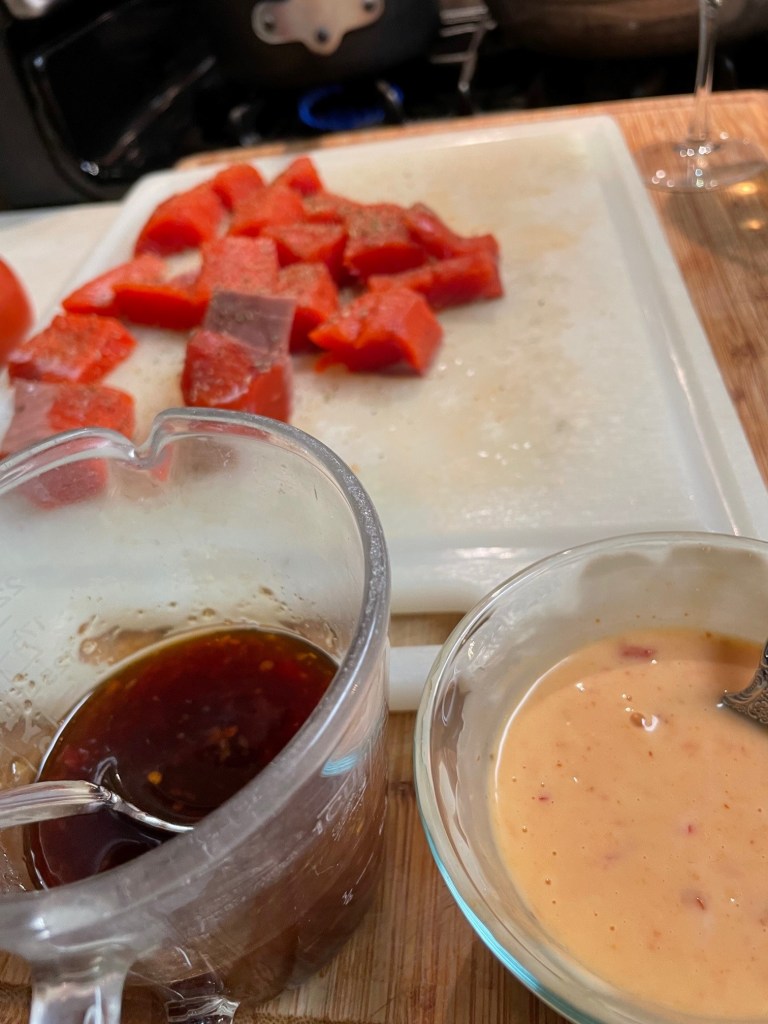
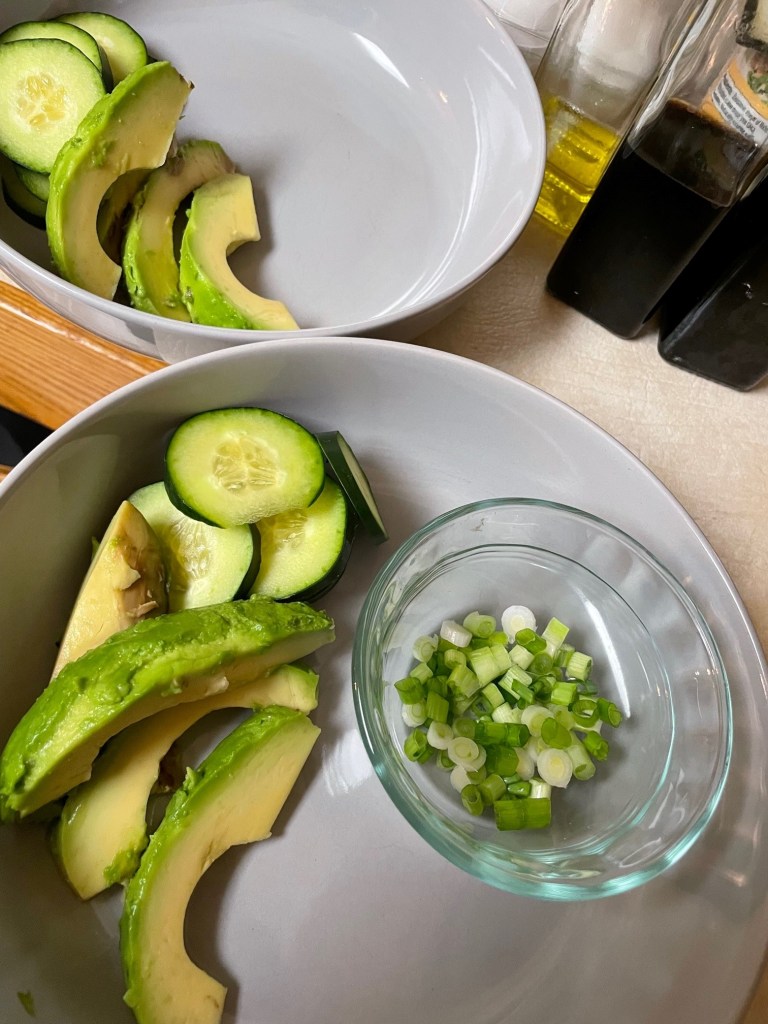

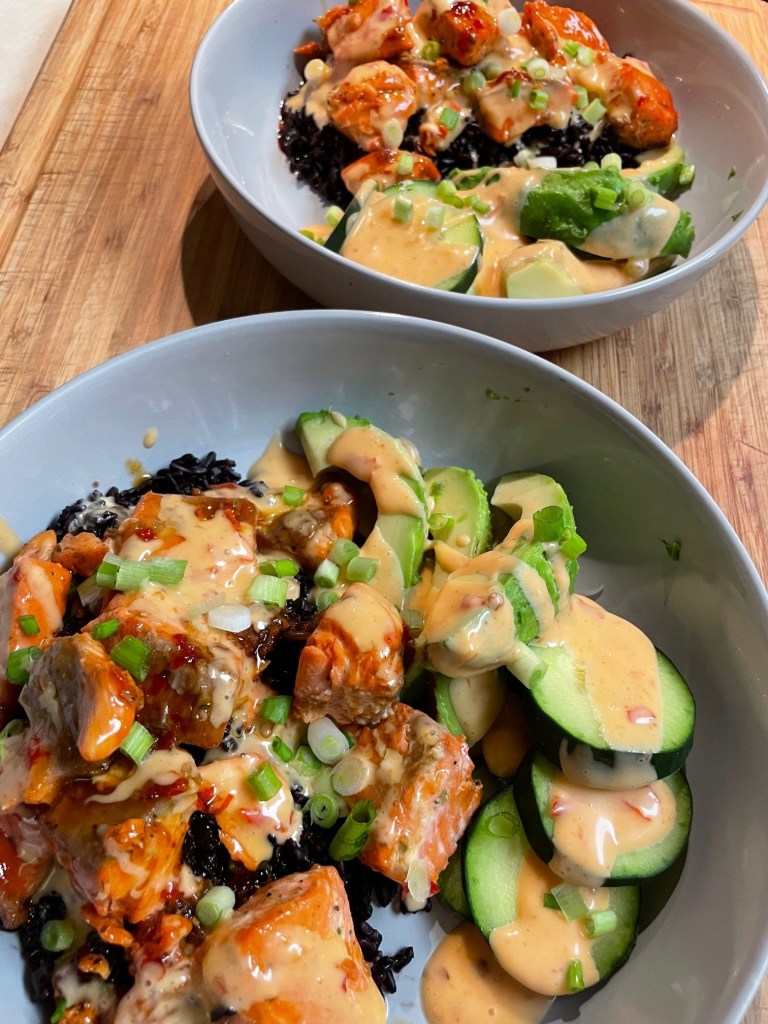

I’ve made this dish several times over the past couple years and it’s really, really delicious. My recipe is based upon one found at TamingTwins, but I’ve modified it quite a bit.
This dish is how I use my leftover salmon that’s already cooked. I haven’t tried it, but I believe canned salmon would work as well. We eat a lot of sweet potatoes because they purportedly are lower in carbs than regular potatoes, but that may just be an advertising ploy by sweet potato growers. Sweet potatoes are commonly called yams in the USA, but real yams are an entirely different vegetable originating in Africa or Asia and most of us have probably never eaten or seen one. That aside, if you’re at the grocery store shopping for yams, almost assuredly they are selling you sweet potatoes. Go ahead and get the yams.
This recipe’s proportions are basically eyeballed. I’ll give you my ingredient proportions, but do feel free to wing it with a handful of this or that. You’ll see. I tend to start by choosing a baking dish that I can spread a layer of flaked salmon evenly across the bottom. The next layer is prawns and onion that has been cooked in milk. TamingTwins poached her salmon with onion in the milk, but I like to use my leftover salmon that’s already cooked. However you decide to do things, the purpose is to flavor the milk with seafood. The next layer is the shrimp and onion-flavored milk made into a white sauce. The next layer is the mashed sweet potatoes mixed with grated cheddar cheese. You can cook the sweet potatoes however you like, they just need to end up mashed. The last layer is grated cheese over the top. This dish is like a shepherd’s pie, but maybe we should call it a fisher’s pie. It may not look like much, but it’s super yummy.
- Ingredients
- 2-3 Sweet potatoes (yams)
- Salt and pepper
- 1 cup grated cheddar cheese, divided
- Cooked salmon, at least two serving pieces
- 1-1/2 cups milk
- 1/2 onion, chopped
- 5 Prawns (extra-large), peeled, deveined, and rough chopped
- 3 Tbsp. butter
- 3 Tbsp. flour
- 1 Tbsp. parsley flakes (optional)
Peel and cut the sweet potatoes into large pieces. Put them into a pot with an inch or so of water and boil/steam until the sweet potatoes are soft. Mash them and then stir in a dash of salt and pepper and 1/3 cup grated cheese. Set aside.
Debone and flake the salmon. Spread it evenly across the bottom of a baking dish. I used a 2-quart dish. Set aside.
Bring milk with onion to a boil in a saucepan and let simmer for a couple minutes until the onion is cooked. Stir in the prawns. Let simmer until they’re cooked. It won’t take long at all, a minute or two. Strain out the onion and prawns, making sure to save the milk. Spread the onions and prawns across the salmon in the baking dish. Set aside. Let the milk cool to room temperature or less. It was zero degrees here while I was last making this, so I just strained the milk into a measuring cup and set it outside to cool. Didn’t take long. Ha.

Preheat the oven to 350 degrees. Make a roux by melting butter in a small saucepan and stirring in the flour, salt, and pepper over medium heat. Stir in the cooled milk and continue stirring over medium heat until the sauce is thick and bubbly. Remove from heat and stir in the parsley flakes, if using (I didn’t have any). Pour the sauce over the seafood in the baking dish.

Dollop mashed sweet potatoes evenly over the filling in the baking dish. You can smooth it out or fluff it up, however you like. Sprinkle with remaining 2/3 cup grated cheese.
Bake at 350 degrees F for 30-40 minutes, until heated through. Heavenly!
I baked this one for thirty minutes, but it could have used another 5-10 in the oven. I was too hungry to wait!
This smoked salmon method is really what most people know as kippered salmon. There is no liquid added, it is a dry brine, very sweet.

In a large bowl, mix together 6 cups brown sugar and 1 cup salt. You can adjust the total amounts as long as you remember it’s 5 or 6 parts of brown sugar to 1 part salt. I use canning and pickling salt.
In a bucket or other container, layer sugar-salt mix with salmon.

One layer at a time until all your fish is used up. Make sure sugar-salt is the top layer. Loosely cover and place in a cool spot for 24 hours or so. I put the bucket on the floor of my basement.

The salt draws out the moisture in the fish so that when you remove the lid the next day, the fish is submerged in liquid. Take the bucket to your work area (my kitchen table).

Draw a bowl of cool water and dip each piece of salmon into it, then place onto baking sheets covered with absorbent towels. Once all the fish is laid out, pat the tops dry with absorbent cloths.

Let the fish sit, under a fan is best, for several hours while a skin develops. Beads of moisture should emerge from the fish, but don’t worry about it if it doesn’t.

Put the fish onto racks in your smoker and smoke as manufacturer suggests. We like mesquite chips. This part takes us about 3 hours or so.
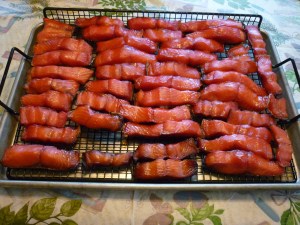
The finished product. Now we will vacuum seal some and can some. We did about 15 sockeye salmon in this batch. There were a lot of small ones.
NOTE: 7/16/2022 Last summer I purchase a Traeger smoker. I smoked my fish on the “Smoke” setting for about 2 to 2.5 hours. Perfect. Oh, and I used 3 Bristol Bay sockeye filets (they average around 8# compared to Kenai/Kasilof/Copper) and about 10 bellies — that filled my Traeger. The brown sugar was 3 cups and the salt was 1/2 cup.

Canning instructions to myself: use the pressure canner. Add water to the level marked over many, many years in the canner. Bring the water to a boil. Load pint jars with smoked salmon chunks and put them into the canner while you’re waiting for the full boil. Once boiling and pints are in, set the lid, but keep the stopcock open. Let the canner boil. Once steam exhausts from the stopcock in a steady stream for ten minutes, shut the stopcock. Let the pressure build to 10. Adjust the stovetop flame to keep a steady 10 pressure for 110 minutes (1 hour and fifty minutes). Remove from heat. Let it cool down for at least an hour before opening the stopcock to release the pressure. Then another hour or so before opening the lid and removing the jars. Wild fluctuations in pressure or overfilled jars will result in the jars exhausting liquid into the canning water. It doesn’t hurt anything, it’s just messy.
Use canned smoked salmon to make dip for crackers by combining 8oz. cream cheese with one pint of flaked canned smoked salmon. You may have to heat the smoked salmon first in order to get it to flake, and then maybe heat the cream cheese to get it to stir properly. I use the microwave for both tasks. This is simply the BEST smoked salmon dip known to creation. Seriously. I kid you not. –Paula
This recipe is not posted on FoodNetwork.com, but it’s from Guy Fieri’s Diners, Drive-ins, and Dives show which can be seen on the Food Network. You can watch the Youtube video if you search for “The Fly Trap in Michigan and Guy Fieri.”
All quantities are eyeballed . . .
Salmon Burgers
In a food processor put:
About 1.5# raw salmon, bones removed, cut into 1” cubes
2 Tbsp. black sesame seeds
¼ cup chopped green onion
2 Tbsp. soy sauce
1 Tbsp. sambala (it’s a spicy Asian condiment—use your own judgement—easy to find, very common)
Form into patties and fry in a little olive oil until done.
Serve on toasted (and perhaps buttered) buns with Aioli Sauce (ingredients follow) and sliced cucumber, sprouts, tomato, cabbage, whatever.
Aioli Sauce: Mayo, lime juice, garlic powder, Dijon mustard. Mix together.



